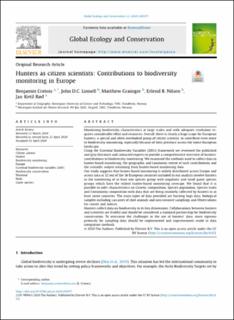| dc.contributor.author | Cretois, Benjamin | |
| dc.contributor.author | Linnell, John Durrus | |
| dc.contributor.author | Grainger, Matthew | |
| dc.contributor.author | Nilsen, Erlend B. | |
| dc.contributor.author | Rød, Jan Ketil | |
| dc.coverage.spatial | Europe, Europa | en_US |
| dc.date.accessioned | 2020-05-12T09:14:13Z | |
| dc.date.available | 2020-05-12T09:14:13Z | |
| dc.date.issued | 2020 | |
| dc.identifier.issn | 2351-9894 | |
| dc.identifier.uri | https://hdl.handle.net/11250/2654028 | |
| dc.description.abstract | Monitoring biodiversity characteristics at large scales and with adequate resolution requires considerable effort and resources. Overall, there is clearly a huge scope for European hunters, a special and often overlooked group of citizen scientist, to contribute even more to biodiversity monitoring, especially because of their presence across the entire European landscape. Using the Essential Biodiversity Variables (EBVs) framework we reviewed the published and grey literature and contacted experts to provide a comprehensive overview of hunters’ contributions to biodiversity monitoring.We examined the methods used to collect data in hunter-based monitoring, the geographic and taxonomic extent of such contributions and the scientific output stemming from hunter-based monitoring data. Our study suggests that hunter-based monitoring is widely distributed across Europe and across taxa as 32 out of the 36 European countries included in our analysis involve hunters in the monitoring of at least one species group with ungulates and small game species groups which have the widest hunter-based monitoring coverage. We found that it is possible to infer characteristics on Genetic composition, Species population, Species traits and Community composition with data that are being routinely collected by hunters in at least some countries. The main types of data provided are hunting bags data, biological samples including carcasses of shot animals and non-invasive samplings and Observations for counts and indices. Hunters collect data on biodiversity in its key dimensions. Collaborations between hunters and scientists are fruitful and should be considered a standard partnership for biodiversity conservation. To overcome the challenges in the use of hunters’ data, more rigorous protocols for sampling data should be implemented and improvements made in data integration methods. | en_US |
| dc.language.iso | eng | en_US |
| dc.rights | Navngivelse 4.0 Internasjonal | * |
| dc.rights.uri | http://creativecommons.org/licenses/by/4.0/deed.no | * |
| dc.subject | Citizen science | en_US |
| dc.subject | Hunter | en_US |
| dc.subject | Biodiversity monitoring | en_US |
| dc.subject | Europe | en_US |
| dc.subject | Essential biodiversity variables (EBV) | en_US |
| dc.subject | Biodiversity conservation | en_US |
| dc.subject | Mammal | en_US |
| dc.subject | Birds | en_US |
| dc.subject | Game species | en_US |
| dc.title | Hunters as citizen scientists: Contributions to biodiversity monitoring in Europe | en_US |
| dc.type | Journal article | en_US |
| dc.description.version | publishedVersion | en_US |
| dc.rights.holder | © 2020 The Authors | en_US |
| dc.subject.nsi | VDP::Matematikk og Naturvitenskap: 400::Zoologiske og botaniske fag: 480 | en_US |
| dc.source.journal | Global Ecology and Conservation | en_US |
| dc.identifier.doi | 10.1016/j.gecco.2020.e01077 | |
| dc.identifier.cristin | 1808965 | |

